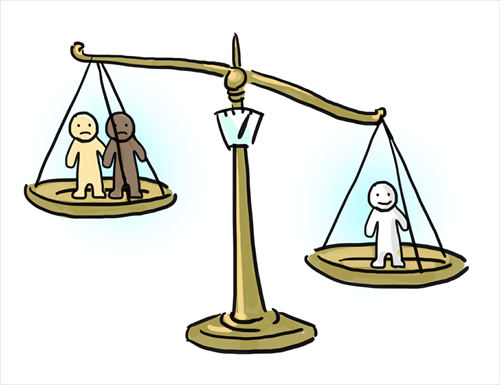HOME >> OP-ED
‘Black Lives Matter’ for Asian-Americans too
By Charles Gray Source:Global Times Published: 2016/7/18 16:58:00

Illustration: Liu Rui/GT
One of the iconic images of the 1992 Rodney King riots in Los Angeles was the image of armed Korean-American store owners patrolling their property. In addition to showing the violence of the time, it also provided a stark reminder that while overshadowed by other racial issues in the US, Asians and blacks have often had a fraught relationship. Beyond other issues, African-Americans were often unfavorably compared to Asians, the supposed US "model minority" in a way that had the effect of setting both groups at odds with each other.
For this reason, the increasing support of the Black Lives Matter (BLM) movement by a growing number of Asian-Americans represents an important sign of positive change in America's racial landscape. In fact, while the specifics of the discrimination these two groups face may at times be different, both groups have faced extensive discrimination in the US.
In fact, many Asian-Americans, especially those of Chinese descent, can point to the long-standing tradition of discrimination that targeted Asians in America, ranging from laws banning Asians from immigrating to the US or becoming naturalized citizens, to the more recent focus on Asian-Americans as a homogeneous "model minority" that ignores the very real challenges still confronting this highly diverse ethnic group.
For example, while Chinese-Americans may not face the violence many African-Americans do, they continue to face the threat of discrimination and even legal persecution based on fears that they may not be "loyal" to the US.
Furthermore, the effective erasure of Asian-American groups that struggle with issues such as poverty and crime by the US media is a form of racial stereotyping that is just as harmful, in its own way, as the focus on crime and poverty in the black community is.
In both cases, a complex issue has been reduced to a misleading and racially biased image that contributes to perpetuating damaging stereotypes.
Equally importantly, Asian-Americans have benefited from the struggle for equal rights in the US. One reason Asian communities are less segregated than black ones is the fact that the major recent waves of Asian immigrants, which came after the 1965 Immigration Act replaced previous exclusionary laws, benefited from the various civil rights cases that had helped strike down segregationist policies, not simply in the South, but all over the US. Without the struggle for civil rights, Asian-Americans would have faced quite a different environment.
For those reasons, the increased Asian-American support for the BLM movement is heartening, in that it recognizes the fact that both have a great deal to lose from a racially biased society, especially when it results in the avoidable death or injury of American citizens. The "Letters for Black Lives" project is one example of this recognition, showing that Asian-Americans are starting to have a conversation about how the BLM movement relates to Asian-Americans and how both groups can work together for their mutual welfare.
For Asian-Americans, the increased awareness regarding the BLM movement found among younger members of the community showcases the fact that the Asian-American community is becoming increasingly assertive in both political and cultural terms, whether it is in fighting against the model minority stereotype or assisting other minorities in finding equal treatment under the law. It is a recognition that the unequal treatment of any group is a danger to all Americans, especially fellow minorities.
By joining with African-Americans, this movement will help to heal the social and racial rifts that have all too often harmed both Asians and blacks. There is few reason for these groups to be hostile to each other, as they both have a shared history of victimization at the hands of racial prejudice in the US. In understanding the benefits to be found in working together, both groups can develop a stronger relationship and move beyond the tensions of the past in order to more effectively face their future in the US.
If the images of armed Korean-Americans standing on the roofs of their shops during the Rodney King riots in 1992 were an example of race relations at their nadir, this new movement represents a sign of how the relationship between Asians and blacks can be transformed into a productive and forward-looking alliance.
Indeed, it should remind all Americans, whatever their race, that the cause for equality in the US is one that everyone should strive for.
The author is a freelance writer based in Corona, California. charlesgray109@gmail.com
Posted in: Viewpoint